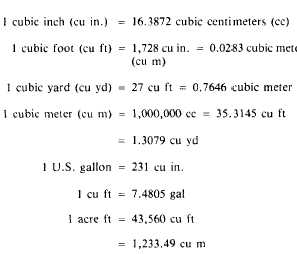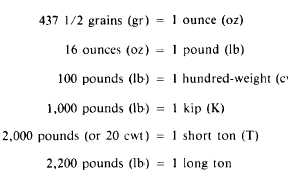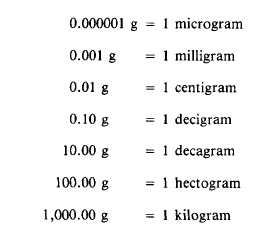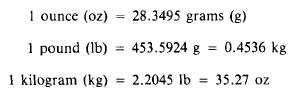and the units used. Remember that your
dimensions must always be expressed in one kind
of unit of measure; for instance, if you are using
the meter, all dimensions must be in meters. The
basic units of volume that you might be using are
as follows:
UNITS OF WEIGHT
The units of weight most frequently used in
the United States for weighing all commodities
except precious stones, precious metals, and drugs
are the units of the so-called AVOIRDUPOIS
system. Avoirdupois units of weight are as
follows:
Precious stones and precious metals are
usually weighed in the United States by the system
of TROY weight, in which there are 12, rather
than 16, oz in the pound. Drugs are weighed by
APOTHECARIES’ weight, in which there are
also 12 oz in the pound.
The basic unit of the metric system of weight
is the GRAM, which contains 15.432 grains. The
GRAIN was originally supposed to be equal to
the weight of a single grain of wheat, The gram
of 15.432 grains is also used in the avoirdupois,
troy, and apothecaries’ system of weights.
Multiples and subdivisions of the basic unit
of metric weight (the gram) are named according
to the usual metric system of nomenclature, as
follows:
A METRIC TON equals 1,000 kilograms,
which equals 1.1 short tons.
The Engineering Aid is interested in the weight
of his instruments and the pull to be applied to
the ends of the tape to give correct linear
measurements. The common units of weight in
surveying are the OUNCE, the POUND, the
GRAM, and the KILOGRAM. The following
tabulation gives the relationship between these
units:
UNITS OF ANGULAR MEASUREMENT
ANGULAR or CIRCULAR MEASURE is
used for designating the value of horizontal and
vertical angles. For general use in the measure-
ment of angles, the circumference of the circle is
divided into some even number of equal parts.
The unit of angular measure is the angle at the
center of the circle subtended by one of the small
subdivisions of the circumference. The various
units of angular measure are known as UNITS
OF ARCS. In practice these units of arcs may
be further expressed in decimal or fractional
parts.
The Engineering Aid may encounter three
systems of angular measure in the use of surveying
instruments. They are the sexagesimal, the
centisimal or metric, and the mil system.
1-29









